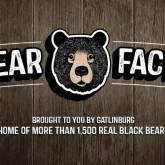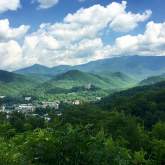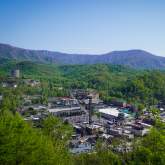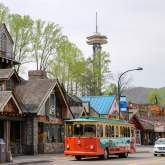Black Bears
An iconic symbol of the Smokies, the American Black Bear, is perhaps the most famous resident of Great Smoky Mountains National Park which provides the largest protected bear habitat in the East. Though populations are variable, biologists estimate approximately 1,500 bears live in the park. While seeing a bear is a wonderful experience, it's important to always be "bear aware." Please review the following tips and information so you know what to do if you encounter a bear in town or on the trail. Learn more on what to do if you see a bear.
Black Bear Safety Tips
Bears are wild and their behavior can be unpredictable. Although extremely rare, attacks on humans have occurred, inflicting serious injuries and death. Treat bear encounters with extreme caution!
- Never approach a bear. Willfully approaching within 50 yards (150 feet), or any distance that disturbs or displaces a bear, is illegal. Violation of this federal regulation can result in fines and arrest.
- Do not allow a bear to approach you.
- If you see a bear, slowly back away from the bear. Do NOT turn and run.
- Make sure the bear is aware of your presence by yelling and making noises to frighten the bear and encourage it to leave.
- Bring children and pets indoors. Groups should stay together, especially children.
- Keep dogs leashed at all times. Don’t let your dog harass a bear. If you see a bear, move away quickly to minimize barking and avoid a confrontation. Dogs are NOT allowed on any trails in Great Smoky Mountains National Park with the exception of the Gatlinburg Trail located behind Sugarlands Visitor Center.
What Can You Do To Protect Bears?
- Do not approach within 50 yards or any distance that disturbs a bear. Use binoculars, telephoto lens, or a spotting scope to view animals.
- Put all trash and food scraps in bear-resistant containers or take it with you. Be sure to close and latch tightly.
- Do not feed or place food to attract bears.
- Do not leave grills or picnic tables unattended.
- Do not leave food in your car or in coolers outside the cabin. If you must store food in vehicles, keep it out of sight.
- Completely close and LOCK all doors and windows of vehicles and buildings. (Yes, bears can open them.)
- Do not feed wildlife. Feeding a bear guarantees its demise!
- Use the food storage cables to store your food and garbage when camping in the backcountry.
- If you see another visitor breaking the above rules, or you encounter a bear, please call (865) 436-1230 to report.
Black Bears in the Smoky Mountains
- Great Smoky Mountains National Park is one of the largest protected areas in the eastern United States where black bears can live in wild, natural surroundings.
- Bears inhabit all elevations of the park. Though populations are variable, biologists estimate that roughly 1,900 bears live in the park. This equals a population density of approximately two bears per square mile. At one time, the black bear's range included most of North America except the extreme west coast. However loss of habitat has resulted in a significant reduction in this range.
- Black bears in the Smokies are black in color, but in other parts of the country they may be brown or cinnamon. They may be six feet in length and up to three feet high at the shoulder. During the summer months, a typical adult male bear weighs approximately 250 pounds while adult females are generally smaller and weigh slightly over 100 pounds. However, bears may double their weight by the fall. Bears over 600 pounds have been documented in the park. Bears can live 12-15 years or more, however bears which have had access to human foods and garbage have a life expectancy of only half that time.
- Bears, like humans, are omnivores. Plant materials such as berries and nuts make up approximately 85% of their diet. Insects and animal carrion provide valuable sources of protein for bears.
- Bears have color vision and a keen sense of smell. In addition, they are good tree climbers, can swim very well, and can run 30 miles per hour.
Black Bear Facts
- Bears are most active during early morning and late evening hours in spring and summer. Mating usually takes place in July. Both female and male bears may have more than one mate during the summer.
- Bears choose a denning site with the coming of cold weather. Dens are usually hollow stumps, tree cavities, or wherever there is shelter. Bears in the Smokies are unusual in that they often den high above the ground in standing hollow trees. Bears do not truly hibernate, but enter long periods of sleep. They may leave the den for short periods if disturbed or during brief warming trends.
- One to four cubs are born during the mother's winter sleep, usually in late January or early February. Bears weigh eight ounces at birth. Females with newly born cubs usually emerge from their winter dens in late March or early April. Commonly born in pairs, the cubs will remain with the mother for about eighteen months or until she mates again.
This information provided by Great Smoky Mountains National Park.




























